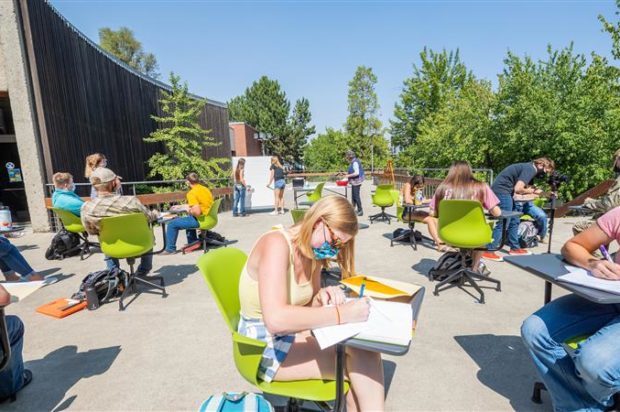
University Of Idaho Reports 9.5% Enrollment Decline Over Last Fall
BY KEVIN RICHERT / IdahoEdNews.org
The University of Idaho’s fall enrollment is down amidst the coronavirus pandemic — with numbers that suggest some demographic challenges for the U of I.
- Fewer high school students are taking dual-credit classes.
- Fewer recent Idaho high school graduates enrolled for fall semester.
- Latino enrollment fell.
All told, the U of I reported fall enrollment of 10,791, a 9.5 percent decrease. But in a Tuesday news release, the university said the decrease was “reasonable,” given students’ reluctance to enroll or return to campus during the pandemic. The U of I reopened in August with a blend of face-to-face and online learning, and has continued face-to-face learning despite coronavirus outbreaks that appear linked to fraternity and sorority houses.
ALSO SEE: Idaho Colleges Look For Budget Help, Possible Enrollment Boost, During COVD Downturn
“We understand the concern of some students,” President Scott Green said Tuesday. “But we hope our success this fall will increase confidence in students across the state. We are actively recruiting for spring and for fall 2021 and are confident students can find their place as a Vandal.”

University of Idaho students attend a College of Natural Resources class outside during the first day of classes on Aug. 24, 2020. Courtesy of UI
The U of I is the first Idaho college or university to release its fall enrollment numbers — and the news follows months of uncertainty. Since the spring, national forecasts have suggested fall enrollment could drop by 20 percent or more, with the pandemic causing students to stay home in droves.
That didn’t exactly happen at the U of I, according to the university’s numbers. Full-time enrollment on the campus fell by only 3 percent.
So what did happen?
Dual-credit enrollment. This single factor accounted for more than half of the 9.5 percent overall enrollment decline. The number of high school students in U of I dual-credit classes fell by close to 600, and even though these students aren’t attending college full-time, their numbers count toward overall enrollment.
For years, Idaho education leaders have touted the state’s growing advanced opportunities program — saying the state’s $4,125-per-student allowance will encourage K-12 students to continue their education after high school, by taking classes at the U of I or other colleges at no cost. If this decline continues — and isn’t an unexpected offshoot of the COVID-19 pandemic, as the U of I described it — it could affect the number of Idaho high school graduates who pursue college.
Idaho student numbers. The numbers from Idaho’s high school class of 2020 also factored in fall enrollment. The number of first-year, first-time Idaho students who showed up on campus fell by 61, or 5.7 percent. This comes not just in the midst of a pandemic, but amidst a multiyear, multimillion-dollar effort to convince Idaho high school graduates to continue their education.
Beyond the in-state numbers, enrollment was a mixed bag. Enrollment in the Western Undergraduate Exchange — a cooperative that allows out-of-state students to enroll at the U of I at a reduced cost — increased by 21 percent. International student enrollment fell by 29 percent, as some international students were unable to come to Moscow for fall classes.
Latino enrollment. Despite ongoing recruitment efforts aimed at the state’s largest ethnic minority, the U of I’s Latino enrollment fell by 35 students, an 8.6 percent decrease. However, enrollment increased among American Indian students (up eight students, or 8 percent), multiracial students (up 50 students, or 14 percent) and Native Hawaiian students (up 10 students, or 27 percent).
Enrollment numbers should come from other colleges and universities within days. Reports are due to the State Board of Education on Friday, and the board could release numbers by early November, spokesman Mike Keckler said Tuesday.
Originally posted on IdahoEdNews.org on October 20, 2020
NOTE: Idaho Education News is an underwriter of NWPB programming, though NWPB is editorially independent. See all NWPB business supporters here. This article is re-published with permission.















